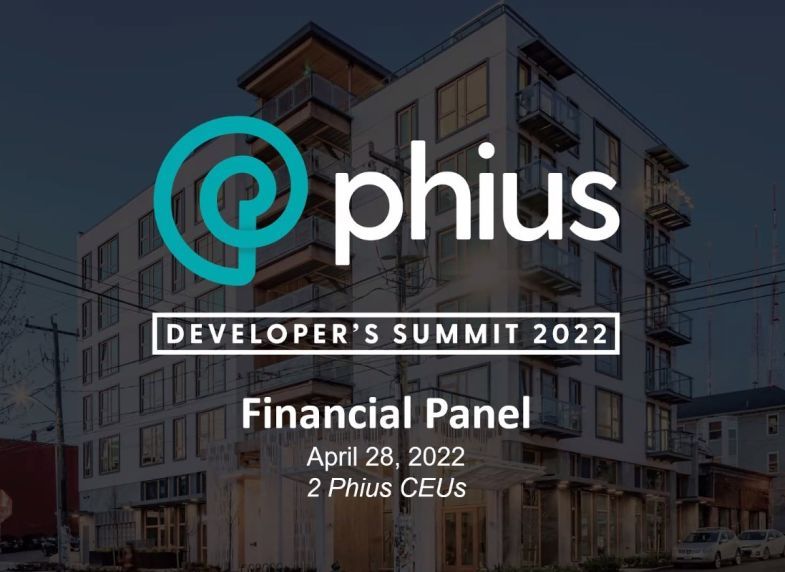
The foundation has been built.
The first-ever Phius Developer’s Summit Presented by Mitsubishi wrapped up last night (April 28), but it felt more like a starting point than an ending. The target audience of the summit was a group that, for the most part, is new to Phius and passive building. With that came the challenge of reaching those who are outside or on the periphery of our network and demonstrating the value of such an event. Add to that the fact this summit was the first of its kind, and we were not quite sure what to expect. But we were thrilled with the turnout, quality of presentations, interaction from attendees, and the overall buzz surrounding the event.
That buzz, which started off as a mutual curiosity between the passive community and developers, is exactly what we plan to build off of in the coming months as we provide more resources for developers. There will be quarterly programming specifically focused on developers, so if you enjoyed the summit or were not able to attend, be on the lookout!
The summit consisted of three days of presentations from passive building experts and Q&A sessions, all meant to introduce and demystify the process of passive building for developers. The topics for each of the three nights – single-family, multifamily and financial – tackled important aspects of what developers need to know about Phius and passive.
Day 1 – Single-Family
Day one was highlighted by insightful opening remarks by economist, climate visionary, and bestselling author Jeremy Rifkin. He gave a broad look at the climate crisis and emphasized the critical role Phius and passive building will play in its mitigation.
"Every building has to be passive. Every building needs to be zero energy. That's the starting point." -- Jeremy Rifkin
Phius Project Certification Manager James Ortega took the baton, giving an overview of the simplification offered by the Phius Prescriptive Path. G O Logic LLC Partner Alan Gibson followed with a look at a cohousing project in Maine that could serve as a blueprint for future communities. Alan also talked about the promise of pre-fab construction and panelization to scale up passive building. Tom Collins of Ball State University and Abigail Lane of Englewood CDC then presented on their collaboration on the Alley House project, an affordable housing development in Indianapolis.
Day 2 – Multifamily
The second day began with a brief introduction by moderator and Phius Policy Specialist Isaac Elnecave during which he discussed some of the policies (incentives, qualified allocation plans, etc.) that are largely responsible for the recent drastic increase in Phius multifamily projects.
Charlene Andres, the Director of Affordable Housing for LUCHA, then gave a look at the process of constructing affordable Phius developments, specifically focusing on Tierra Linda, a mid-rise project in Chicago. Cascade Built Founder and President Sloan Ritchie followed with the market-rate perspective, discussing a number of Phius projects in Seattle, including the award-winning 1300 Pike project. Christoph Stump of Trinity Financial closed with an in-depth look at the mixed-use, affordable housing 425 Grand Concourse project in the Bronx, which is the largest Phius certified project to date.
“Building to less than passive might be legal… but it’s irresponsible.” -- Sloan Ritchie
Day 3 – Financing
The summit finale was moderated by none other than Katrin Klingenberg, Phius’ Co-Founder and Executive Director. She set the scene for the financial panelists by outlining some promising performance and cost data from Phius projects.
Megan Spitz of the Illinois Housing Development Authority then took the reins to discuss her experience with Low Income Housing Tax Credits and Qualified Allocation Plans in Illinois. She also took a look at recent changes in Illinois and their potential future effects on passive building. That presentation segued nicely into ICF Senior Manager Mark Pignatelli’s discussion of the Mass Save and Energize Connecticut funding programs, and potential expansion to other states.
“This is just the beginning of the conversation.” -- Katrin Klingenberg
John Todd of LEX Markets answered the question of what IPOs have to do with passive building by explaining his organization's effort to take the 1300 Pike project public, allowing the building owners to liquidate much quicker and giving access to both accredited and non-accredited investors. This presents a promising new frontier for developers, as it allows them to financially leverage the quality of passive projects much earlier than they would otherwise be able to do. Stacey Hobart of New Buildings Institute capped off the presentations with yet another funding opportunity – low-carbon financing.
We would be remiss not to extend a huge thank you to our Event Sponsor Mitsubishi and Event Partner New Buildings Institute, as well as the attendees and all the extraordinary panelists for sharing their wisdom, including Jeremy Rifkin, who perfectly set the stage for the event with his opening remarks. We also want to recognize the tireless work of our staff, who made this event possible.
If you missed the summit, recordings will be available for purchase.
The Developer’s Summit laid a solid foundation for the relationship between Phius and developers, but we are far from finished. Stay tuned in the coming weeks for more!